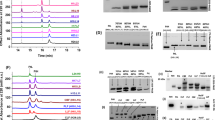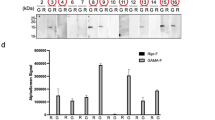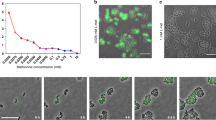Abstract
PROTEINS which bind biotin do not seem to be widely distributed in nature, possibly because their function seems to be restricted to that of a somewhat inefficient antibacterial agent. Until recently, avidin had been detected only in the egg-white of birds and in the homologous egg jelly of frogs1. In 1963 an avidin-like protein was discovered as part of an antibiotic system in culture filtrates of several species of Streptomyces2. This protein, called streptavidin, was purified, crystallized and characterized by Chaiet and Wolf3, who found that it resembled egg-white avidin both in possessing four biotin binding sites (one/15,000g) with great affinity for biotin and in some aspects of its amino-acid composition (high tryptophan and threonine, low methionine, proline and histidine). Many of the characteristics of the biotin binding mechanism were also similar. There was a redshift of the tryptophan absorption band accompanying the binding of biotin, and at the same time the biotin protected four tryptophan residues in each sub-unit against oxidation by N-bromosuccinimide (ref. 4 and my unpublished work). Like avidin, streptavidin also bound the dye 4-hydroxy-azobenzene-2′-carboxylic acid giving a new absorption band at 500 mµ which disappeared when the dye was displaced by biotin5. Some of the physico-chemical characteristics of these two proteins and of hen egg-white lysozyme are summarized in Table 1.
This is a preview of subscription content, access via your institution
Access options
Subscribe to this journal
Receive 51 print issues and online access
$199.00 per year
only $3.90 per issue
Buy this article
- Purchase on Springer Link
- Instant access to full article PDF
Prices may be subject to local taxes which are calculated during checkout
Similar content being viewed by others
References
Sebrell, W. H., and Harris, R. S., The Vitamins, 1, 555 (Academic Press New York, 1954).
Stapley, E. O., Mata, J. M., Miller, I. M., Demny, T. C., and Woodruff, H. B., Antimicrobial Agents and Chemotherapy, 20 (American Society for Microbiology, 1963).
Chaiet, L., and Wolf, F. J., Arch. Biochem. Biophys., 106, 1 (1964).
Green, N. M., Biochem. J., 89, 599 (1963).
Green, N. M., Biochem. J., 94, 23C (1965).
Green, N. M., Biochem. J., 89, 585 (1963).
Green, N. M., and Melamed, M. D., Biochem. J., 100, 614 (1966).
Green, N. M., Biochem. J., 92, 16C (1964).
Hayashi, K., Imoto, T., and Funatsu, M., J. Biochem., Tokyo, 54, 381 (1963).
Canfield, R. E., J. Biol. Chem., 238, 2698 (1963).
Ikeda, K., Hamaguchi, K., Imanishi, M., and Amano, T., J. Biochem., Tokyo, 62, 315 (1967).
Glazer, A. N., and Simmons, N. S., J. Amer. Chem. Soc., 88, 2335 (1966).
Green, N. M., Biochem. J., 101, 774 (1966).
Melamed, M. D., and Green, N. M., Biochem. J., 89, 591 (1963).
Rupley, J. A., Butler, L., Geming, M., Hartdegen, F. J., and Pecoraro, R., Proc. US Nat. Acad. Sci., 57, 1088 (1967).
Dahlquist, F. W., Jao, L., and Raftery, M., Proc. US Nat. Acad. Sci., 56, 26 (1966).
Ward, J. B., and Perkins, H. R., Biochem. J. (in the press).
Ward, J. B., thesis, Bath Univ. of Technology (1967).
Brew, K., and Campbell, P. N., Biochem. J., 102, 258 (1967).
Brew, K., Vanaman, T. C., and Hill, R. L., J. Biol. Chem., 242, 3747 (1967).
Walsh, K. A., and Neurath, H., Proc. US Nat. Acad. Sci., 52, 884 (1964).
Braunitzer, G., Hilse, K., Rudloff, V., and Hilschmann, N., Adv. Prot. Chem., 19, 1 (1964).
Green, N. M., Biochem. J., 89, 609 (1963).
Bryson, V., and Vogel, H. J., Evolving Genes and Proteins (Academic Press, New York and London, 1965).
Hartley, B. S., Brown, J. R., Kauffman, D. L., and Smillie, L. B., Nature, 207, 1157 (1965).
Atassi, M. Z., J. Theor. Biol., 11, 227 (1966).
Meyer, K., Science, 99, 391 (1944).
Author information
Authors and Affiliations
Rights and permissions
About this article
Cite this article
GREEN, N. Evidence for a Genetic Relationship between Avidins and Lysozymes. Nature 217, 254–256 (1968). https://doi.org/10.1038/217254a0
Received:
Published:
Issue Date:
DOI: https://doi.org/10.1038/217254a0
This article is cited by
-
Induction of an antimicrobial biotin-binding egg white protein (avidin) in chick tissues in septicEscherichia coli infection
Experientia (1980)
-
Lysozyme Ergebnisse und Probleme
Klinische Wochenschrift (1968)
Comments
By submitting a comment you agree to abide by our Terms and Community Guidelines. If you find something abusive or that does not comply with our terms or guidelines please flag it as inappropriate.



